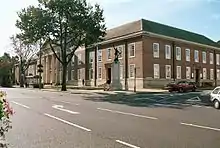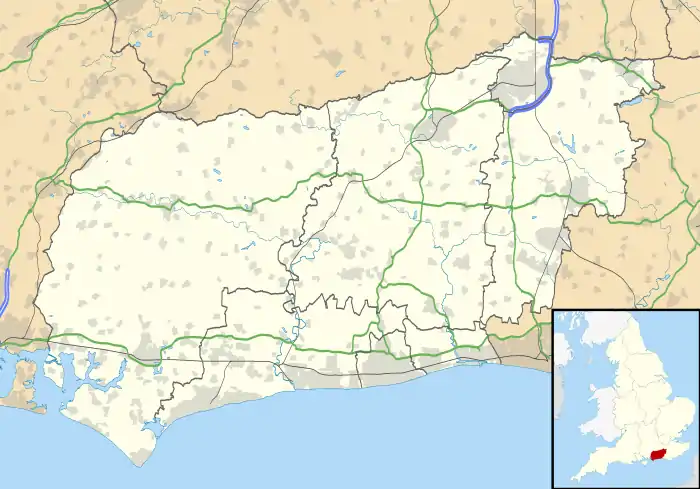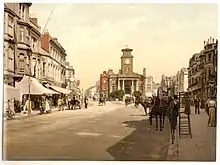Worthing Town Hall
Worthing Town Hall is a municipal building in Chapel Road, Worthing, West Sussex, England. The town hall, which is a meeting place of Worthing Borough Council, is a Grade II listed building.[1]
| Worthing Town Hall | |
|---|---|
 Worthing Town Hall | |
| Location | Chapel Road, Worthing |
| Coordinates | 50.8148°N 0.3719°W |
| Built | 1934 |
| Architect | Charles Cowles-Voysey |
| Architectural style(s) | Neo-Georgian style |
Listed Building – Grade II | |
| Official name | Worthing Town Hall including Assembly Hall and Worthing Room |
| Designated | 19 January 1982 |
| Reference no. | 1250786 |
 Shown in West Sussex | |
History

The town commissioners in Worthing originally met in the Royal Oak Public House in Market Street.[2] In the 1820s the commissioners decided to procure a dedicated town hall: the site they selected at the north end of South Street was a garden owned by the Sir Timothy Shelley (the father of the novelist, Mary Shelley) whose seat was at Castle Goring.[2] The first town hall, which was designed in the neoclassical style with a tetrastyle portico and a clock tower was completed in June 1835.[2][3] The town hall also acted as a courthouse for hearing quarter sessions and assizes.[2]
In the 1920s civic leaders decided that the first town hall was inadequate[lower-alpha 1] and decided to procure a new building: the site they selected this time had been occupied by two large residential properties.[4] The war memorial at the site, which takes the form of a bronze statue of a soldier holding a rifle mounted on a stone plinth, pre-dates the town hall: it was sculpted by Joseph Whitehead and Sons and unveiled by Field-Marshal Sir William Robertson on 11 April 1921.[5]
Construction of the second town hall commenced on 1 October 1931.[6] It was designed by Charles Cowles-Voysey in the Neo-Georgian style, built in red brick with ashlar stone dressings at a cost of £398,117 and was officially opened by Prince George on 22 May 1933.[7] The design involved a symmetrical main frontage with nineteen bays facing onto Chapel Road; the central section of nine bays, which slightly projected forward, featured a three-bay tetrastyle portico with Ionic order columns supporting an entablature inscribed with the words "Ex terra copiam e mari salutum" (English: "From the land fulness and from the sea health") and a large pediment.[1] There was a clock tower and a cupola with Tuscan order columns, which was capped with a finial, at roof level.[1] Internally, the principal rooms were the council chamber and the mayor's parlour: a map of Worthing, painted with oil paints on a wooden panel, was commissioned from the cartographer, MacDonald Gill, and installed in the mayor's parlour.[8]
A large assembly hall, with a proscenium arch was built as a separate structure to the rear of the main building and also completed in 1933.[1] The foyer of the assembly hall was decorated with two panels, one on the left and the other on the right, each designed by the sculptor, Laurence Bradshaw, and depicting a male figure standing astride two fishes.[9] In October 1934, the town hall was the starting point for the Battle of South Street, a riot which took place in the town as members of the British Union of Fascists and various anti-fascist protesters clashed after a newly elected fascist councillor, Charles Budd, failed to secure the committee places he desired on the council.[10]
The town hall continued to serve as the headquarters of the local municipal borough council for much of the 20th century and remained the local seat of government after the formation of the enlarged Worthing Borough Council in 1974.[11] Princess Alexandra and the Duchess of Gloucester visited the town hall on 20 June 2000 and 20 June 2006 respectively to take part in lunches for disabled war veterans on excursions from London.[12] In November 2015, the council agreed that the town hall should be registered as a venue for marriages and civil partnerships.[13]
See also
Notes
- The clock tower was found to be unsafe and was removed in the 1950s and the building as a whole was demolished in 1966.[2]
References
- Historic England. "Worthing Town Hall including Assembly Hall and Worthing Room (1250786)". National Heritage List for England. Retrieved 31 January 2021.
- "The building that stood at the heart of Worthing". Shoreham Herald. 22 May 2014. Retrieved 31 January 2021.
- Baggs, A. P.; Currie, C. R. J.; Elrington, C. R.; Keeling, S. M.; Rowland, A. M. (1980). "'Worthing: Local government and public services', in A History of the County of Sussex: Volume 6 Part 1, Bramber Rape (Southern Part), ed. T P Hudson". London: British History Online. pp. 114–119. Retrieved 1 February 2021.
- "Ordnance Survey Map". 1912. Retrieved 31 January 2021.
- Historic England. "Worthing War Memorial (1447552)". National Heritage List for England. Retrieved 31 January 2021.
- "History of Worthing Town Hall and the Mayoralty". Adur and Worthing Councils. Retrieved 31 January 2021.
- "Programme and Souvenir for the opening of Worthing Town Hall". National Archives. Retrieved 31 January 2021.
- "MacDonald Gill - the story behind the West Sussex mapmaker and architect". Sussex Life. 29 June 2020. Retrieved 31 January 2021.
- "Two decorative plaques". Public Sculptures of Sussex. Retrieved 31 January 2021.
- Hare, Chris (1991). Historic Worthing: The Untold Story. Cassell Reference. pp. 175–176. ISBN 978-0900075919.
- Local Government Act 1972. 1972 c.70. The Stationery Office Ltd. 1997. ISBN 0-10-547072-4.
- "Royal Visits to West Sussex". Lord Lieutenant. Retrieved 31 January 2021.
- "Town hall weddings proposal approved". Worthing Herald. 4 November 2015. Retrieved 31 January 2021.